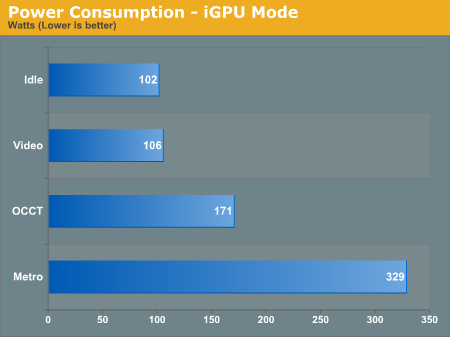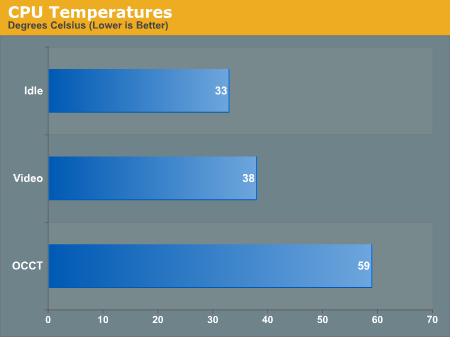ASUS P8P67 Review
by Brendan van Varik on September 8, 2011 10:45 AM EST- Posted in
- Asus
- Motherboards
- P67
Test Setup
| Processor |
Intel Core i5 2500K ES 4 cores, 4 threads, 6MB L3 |
| Motherboards | ASUS P8P67 |
| Cooling | Thermalright Ultra 120 eXtreme with one 120MM fan |
| Power Supply |
Silverstone 1000W Silver (Power Testing) OCZ ZX Series 1250w 80 PLUS Gold |
| Memory | Patriot Viper Extreme DDR3-2000MHz 9-11-9-27 2x4GB - 1.65v |
| Memory Settings | DDR3-1333MHz - 9-9-9-24 1T at 1.65v |
| Video Cards | Sapphire HD 5850 1GB |
| Video Drivers | Catalyst 10.12 |
| Hard Drive | Crucial C300 |
| Optical Drive | Samsung SH-S223Q |
| Case | Dimastech Bench Table |
| Operating System | Windows 7 64-bit |
| SATA Testing | Crucial C300 |
| USB 2/3 Testing | Patriot 64GB SuperSonic USB 3.0 |
Note - we will be moving to more recent drivers soon. We still use the 10.12 at the minute to keep parity between motherboard reviews, but this will be updated in the near future.
Comparison to Previous Results:
Power consumption was tested on the system as a whole with a wall meter connected to the power supply, while in a dual GPU configuration. This method allows us to compare the power management of the UEFI and the board to supply components with power under load, and includes typical PSU losses due to efficiency. These are the real world values that consumers may expect from a typical system (minus the monitor) using this motherboard.

CPU Temperatures
With most users running boards on purely default BIOS settings, we are running at default settings for the CPU temperature tests. This is, in our outward view, an indication of how well (or how adventurous) the vendor has their BIOS configured on automatic settings. With a certain number of vendors not making CPU voltage, turbo voltage or LLC options configurable to the end user, which would directly effect power consumption and CPU temperatures at various usage levels, we find the test appropriate for the majority of cases. This does confict somewhat with some vendors' methology of providing a list of 'suggested' settings for reviewers to use. But unless those settings being implemented automatically for the end user, all these settings do for us it attempt to skew the results, and thus provide an unbalanced 'out of the box' result list to the readers who will rely on those default settings to make a judgement.

The temperatures which I recorded are higher than motherboards from other manufacturers in a similar price bracket.










52 Comments
View All Comments
Blaster1618 - Thursday, September 8, 2011 - link
I am so tired of LGA-1155 being portrayed as an "Enthusiast Board"-Dual-channel memory.
-Narrow PCI Bus.
-Virtually fixed core clock.
-and the stake to the heart....on board graphics.
Wait...wait LGA-2011 and i7 3-series will spice up the M-board review business.
zero2dash - Thursday, September 8, 2011 - link
Troll much?Onboard graphics has no performance penalty on a 2600K (let alone a 2500K) so throw that piss poor reason out the window.
Narrow PCI bus? Yes, because that's clearly dragging SB systems through the mud. So is the dual channel memory.
Fixed core clock? Who gives a crap? Yeah, because a locked core clock with an unlocked multiplier is a worse option than an unlocked core clock and a limited amount of multiplier options.
Have fun paying for those quad channel ram kits.
A5 - Thursday, September 8, 2011 - link
A) Memory bandwidth has very little discernible effect on non-benchmark applications. Modern CPUs are so good at cache management that there is almost 0 reason to chase memory bandwidth. Ironically, the 1156 CPUs probably need the bandwidth more (due to the onboard graphics) than the 2011 CPUs will.B) If you need more than two PCI-e x8 slots, then you're the kind of person who will drop the cash on LGA-2011 anyway. This is a legit knock against P67 and Z68, but it also only affects the hardcore enthusiasts, the top 1% of the top 1% who are running 3 or 4 GPUs.
C) LGA-2011 is going to have fixed clocks too. With multipliers unlocked, this is kind of a moot point anyway.
D) Considering P67 doesn't even allow you to use the onboard graphics, I don't see how this is a valid complaint.
I think P67 is a perfectly acceptable "enthusiast" product, and honestly I'd be surprised if there is an LGA-2011 version of Ivy Bridge outside of the server space.
RussianSensation - Thursday, September 8, 2011 - link
You should leave him alone :)He is probably going to future-proof his LGA-2011 setup with 32GB (4x8GB) for $1200:
http://www.newegg.com/Product/Product.aspx?Item=N8...
....because 32GBs in Quad-Channel LGA2011 Pawwwwwwwns all!
Blaster1618 - Saturday, September 10, 2011 - link
Not Hating... but I figured as soon as the Z series board was out, the H&P series boards would drop, rightfully so, in the bargain bin.I obvious to me that the 2nd generation i7 have an internal memory architecture limitation. (ie they were not designed for enthusiasts) Cut and paste old North Bridge architecture on the die. The bandwidth(bitwidth) of the internal communication 3rd generation chips is nearly twice the 2nd generation and it has 20 Gbit DMI 2.0.
If you don't believe bandwidth matters, I have a bin full old 64 bit Geforce cards for sale. I play games on my X-box, My computers for Solid modeling and Finite element analysis and surfing pron.
I was under the understanding the issues with the base clock adjust-ability were issues with the on board GPU's sensitivity to frequency. I am hoping the base clock on the I7 3820 will have 30-40% overclock like the LGA1366 or my old E6600.
At <$300 the i7 3820 should be quite a deal ps my business picks up the $1,200 for the 32 GB of Corsair XMS.
RussianSensation - Thursday, September 8, 2011 - link
2500k - $220This board - $135
vs. i7-990X
http://www.xbitlabs.com/articles/cpu/display/core-...
Care to explain how a $355 mobo+cpu setup trades blows with an overclocked $999 i7 CPU on "enthusiast" LGA1366?
I hope you enjoy your $300 LGA2011 Motherboard + $500-1000 CPU for 1 quarter until IVB launches and obsoletes LGA2011 for anyone but workstation users.
Etern205 - Friday, September 9, 2011 - link
pfff....Yep, have fun waiting for that Ivy Bridge of yours....
http://vr-zone.com/articles/the-upgrade-path-to-iv...
CharonPDX - Thursday, September 8, 2011 - link
If you've used any Intel Desktop Board in the past three years, you've used a UEFI-based configuration utility. It's just one designed to look like an old fashioned 'BIOS' screen. (P.S., technically it hasn't been a "BIOS" in a while, it's been a configuration utility.)Concillian - Thursday, September 8, 2011 - link
So why is the P8P67 consuming 20 more watts at idle than the P8P67 Pro in it's review?Shouldn't the less featured board be using less power?
Mumrik - Thursday, September 8, 2011 - link
I looked around for a relatively cheap motherboard with 8+ SATA ports for a 2500k and this board was by far the cheapest. Reading up in forums (especially at the [H] where Asus is active) and at Newegg I got the impression that there was an unusual amount of problems with the generation of Asus boards, so I chickened out and picked up an Asrock instead.